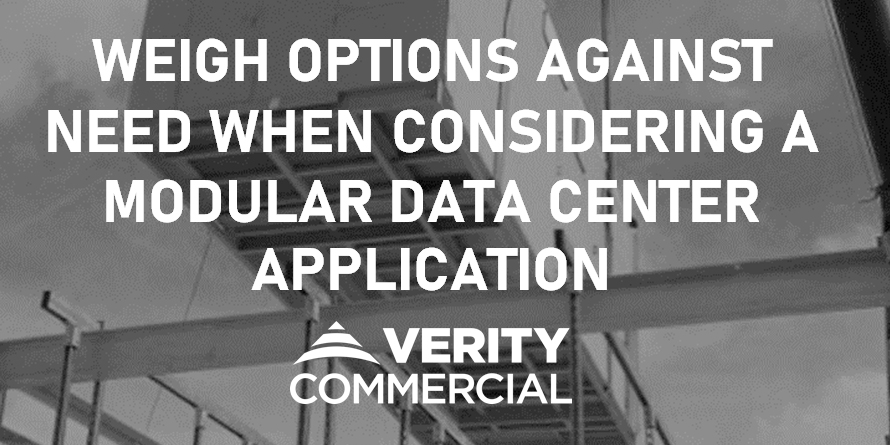Weigh Options Against Need When Considering a Modular Data Center Application

Modularity is a growing trend in data center construction, and with good reason. Shorter lead times in this highly competitive rush-to-market environment are one possible advantage, as are the potential for reduced costs and the relative ease of on-site connectivity compared to traditional (so-called stick-built) methods. Then comes scalability. Modular designs allow users to right-size their facility based on current demand, changing the strategy from a just-in-time to an inventory approach.
These are just a few of the reasons why we at Verity Commercial are fielding a growing number of inquiries about modular design. But, as good as it sounds, this isn’t a yes or no question. It’s one of nuance and need, revolving around the issue of whether modularity is right for you, and it can be done wrong, without proper guidance and critical input. Our aim is to help clients weigh the relative benefits of stick-built versus modular methods and, if the choice is the latter one, to modularize in ways that make the most sense.
To do so, we have to begin by defining terms. There are many types of modular design, all essentially packaging components together and assembling them off-site. One popular package, for instance, calls for the delivery of all electrical components on a single skid. It’s most appropriate for organizations with design needs that remain consistent from facility to facility.
Savings Are Impressive But Dependent on a Variety of Factors
No matter the configuration, all equipment contained in the package has been Factory Acceptance Tested (FAT) in a controlled environment, which addresses the all-important quality issue. In terms of costs, these too can be dramatically reduced. Savings as high as 84 percent have been reported on items converted to offsite assembly, and capital cost savings of roughly two percent are possible.
But the complete pricing picture has to be folded into the strategy. Roughly speaking, new-construction data centers can run in the $6-million-to-$9-million range per megawatt (MW). Modular done well can push the lower end of that range, but so will stick-built done well. Depending on factors such as locale, local regulation and vendor cost, our experience has shown certain modular projects can actually run at a premium to stick-built. For this reason, clients that have opted for modular assets tend to do so more for the advantages of timing and quality rather than cost savings.
It should be noted as well that the benefits of speed and scheduling come at the price of customization. Almost by definition, stick-built centers are customized. The modular customer always has the option to change things up, be it rearranging the skid, its color or the equipment. But such changes mean re-engineering, procuring new materials and flying in the face of the essential benefits of modular designs.
We mentioned location as a dynamic of pricing. Just as you might save significant dollars buying items in bulk for your home, clustered data centers bring a “bulk” dynamic to the construction process and can drive down costs per MW. Planning, designing and building data centers on a one-off basis, location by location, subjects end-users to varying local requirements as well as different providers working toward different price points.
Benefits Accrue From a Location Chosen for Its Data Center Clusters
By contrast, in Northern Virginia, let’s say, in what’s known as Data Center Alley, there are no fewer than 118 data centers between Loudoun and Fairfax counties. Here, enterprising contractors have set up centrally located prefabrication facilities where all components are built and thoroughly tested. If an end-user decides on Northern Virginia as the site of their next three or four data centers, partnering in a service-level agreement with such a prefabrication shop delivers on three key goals over an open bid done on a one-off basis:
- Reductions in construction time and cost;
- The availability of components and materials; and
- A consistent level of quality from project to project.
In addition, local clustering also minimizes the bureaucracies of authorities having jurisdiction (AHJ), again contributing to speed to market.
Clearly, the construction/vendor community is becoming increasingly clever in ways to satisfy the schedule, budget and quality goals of their clients. Modularity is simply the latest iteration of that drive to customer satisfaction.
Partner With Your Providers to Ensure a Result That Fits the Vision
But even modularity demands that those goals be clearly stated and executed. This in turn points to a partnership between client and provider. In this way, modular design is no different than stick-built methodologies. Verity Commercial has stated before in this space the importance of pilots and co-pilots. Partners on the same page throughout the process are the one way to ensure your data center project delivers on the client vision–whether your approach is traditional or modular.
Contact Verity Commercial today to discuss in depth the details of modular design.
Additional Resources:
TCO Analysis of a Traditional Data Center vs. a Scalable, Prefabricated Data Center
The Future of Data Center Design is Modular
Why Is Ashburn Known as Data Center Alley?
# # #
Comments